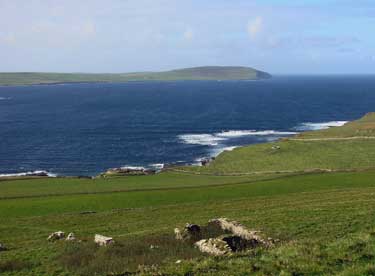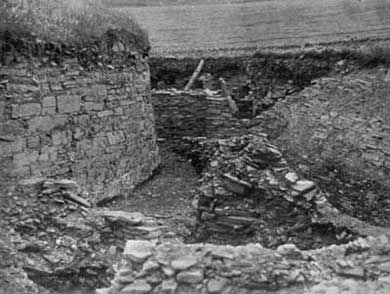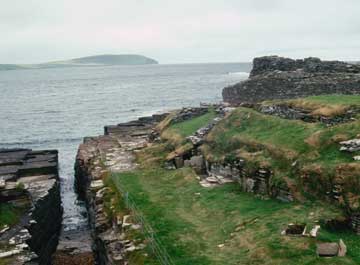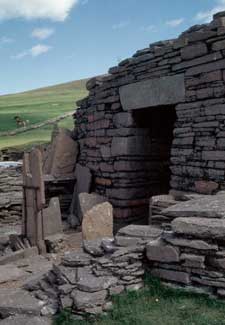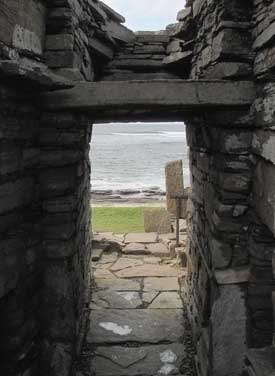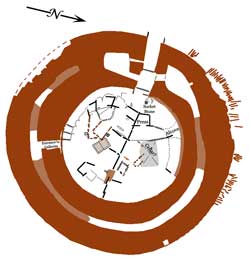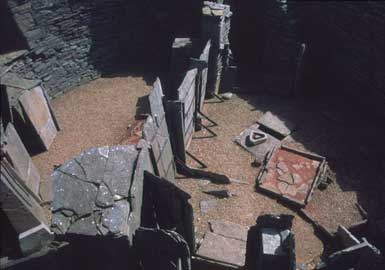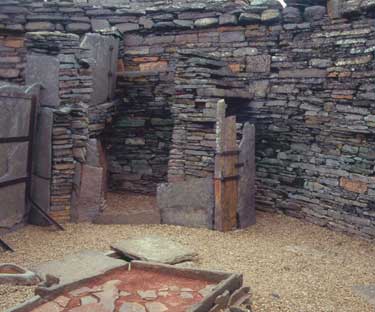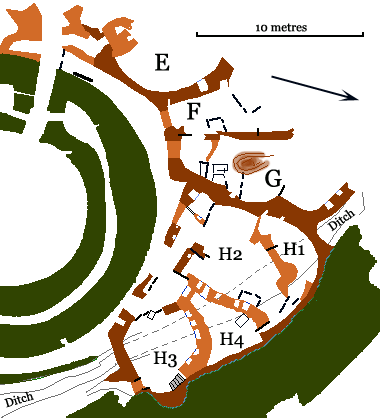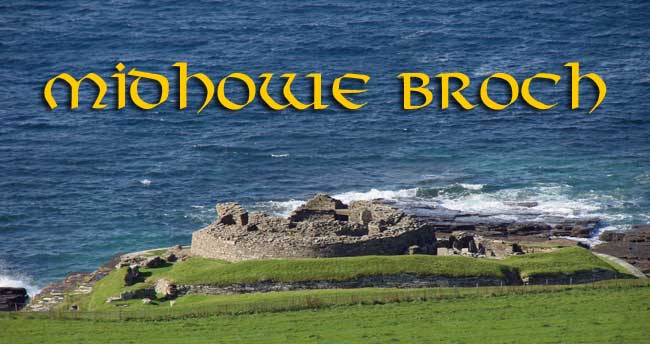
Midhowe is on the opposite side of Eynhallow Sound from Gurness, on the island of Rousay, one of a number of brochs that line the southern shore. The sites are intervisible and have a lot in common. The similarities are such that many scholars suspect that specialist broch architects were at work. The entire site, including the outbuildings, ramparts and ditches, was excavated in the early 1930s by Graham Callander and Walter Grant (Proceedings of the Society of Antiquaries, Scotland, Vol. 68 [1933-34]). What distinguishes the arrangement found here from those at Gurness and Lingro is the fact that the entrance to the site faces the opposite direction to that of the broch, so that the formal approach (if there was such a thing) was from the sea.
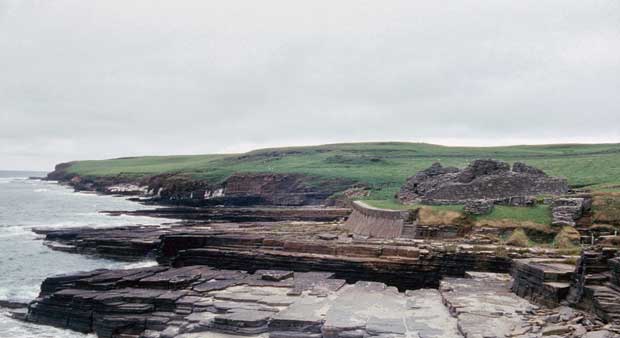
View of Midhowe Broch from the South
The site is located quite close to the rocky shoreline, flanked by two narrow inlets, known locally as geos. Cutting off the end of a promontory with ditches and embankments was a common feature of the Iron Age in Atlantic Europe and examples can be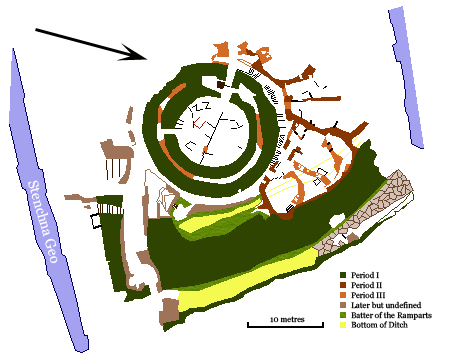 found as far south as Brittany. The site has clearly suffered from coastal erosion and part of the settlement has disappeared. It is impossible to say how much but, based on the arrangements at Gurness and Lingro where most of the outbuildings were in front of the broch, it is likely to have been substantial. Nowadays the site is protected by a concrete retaining wall but, even so, it is periodically pounded by the waves whenever there is a gale and would be, to all intents and purposes, uninhabitable, particularly since the entrance is located on the seaward side. Presumably the shore was considerably further away in the Iron Age.
found as far south as Brittany. The site has clearly suffered from coastal erosion and part of the settlement has disappeared. It is impossible to say how much but, based on the arrangements at Gurness and Lingro where most of the outbuildings were in front of the broch, it is likely to have been substantial. Nowadays the site is protected by a concrete retaining wall but, even so, it is periodically pounded by the waves whenever there is a gale and would be, to all intents and purposes, uninhabitable, particularly since the entrance is located on the seaward side. Presumably the shore was considerably further away in the Iron Age.
The ‘Defences’
A massive stone rampart runs between the two geos but does not quite link them, stopping about six metres short of Stenchna Geo to the south. It has been robbed to some degree but still stands about 1.5-2 metres high, measuring from the base of the outer ditch, and a little over 3 metres from the base of the inner ditch. It is 43 metres long and broadens considerably at the southern end. Where the stonework has been investigated, on the outward face, there is an outer skin of flagstones laid flat but, in the interior, they are set on edge and at an angle. The wall has a substantial batter on both sides and, for most of its length, measures nearly 8 metres thick at the base and 5.9 metres across at the top. As the wall nears its southern end, it suddenly becomes broader (9.5 metres) to form one side of the entrance passage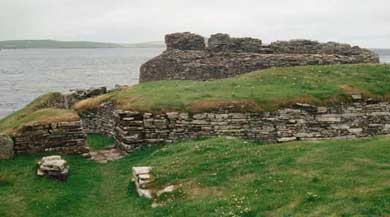 . After a gap of about a metre and a half for the entrance to the passage, the face of the rampart continues for another 4 metres before it stops short of the inlet, at the edge of a vertical rock face 1.5 metres high, and turns abruptly westwards.
. After a gap of about a metre and a half for the entrance to the passage, the face of the rampart continues for another 4 metres before it stops short of the inlet, at the edge of a vertical rock face 1.5 metres high, and turns abruptly westwards.
The passage was later modified by additional walling but it appears to have carried on for at least 16 metres where the side walls come to an end but may well have gone further, around to the front of the broch. The entrance is much narrower than the passage, which is 2 metres or so across and follows a slightly sinuous course to start with. There are door checks at the start of the passage and another set further along, built into the latter wall faces on either side. Not far from the end of the southern wall is a small opening, about 75 cm wide, where a set of steps leading up from the rocky shelf next to the geo.
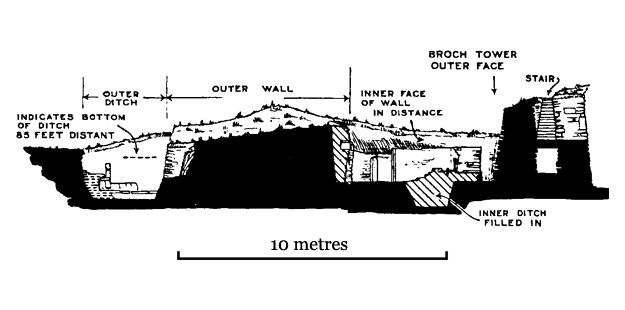
East-West Section of the Outer Defences
The ditches are both flat-bottomed with sloping sides revetted with masonry. In the case of the outer ditch, the scarp is simply a continuation of the face of the rampart. They vary a bit in width (between 2 and 3.5 metres at the top) but are fairly consistent in depth, perhaps a metre or so belong the original ground surface. They are very much a unit with the rampart, particularly the long stretch to the north of the main entrance. At some point, it was decided to lay a long stretch of flagstone paving at the base of the outer ditch and houses were built over the corresponding part of the inner one.
The Broch
As was the case at Gurness, there was a narrow ground floor gallery that ran right around the building and, as at Gurness, this caused severe structural problems. At Midhowe, it would appear that the builders first tried bracing it with narrow flagstones wedged into the ground but in the end, just as at Gurness, they had to pack the space with stone to prevent a total collapse. This would have been an extremely awkward undertaking given the cramped space in which the builders would have had to work.
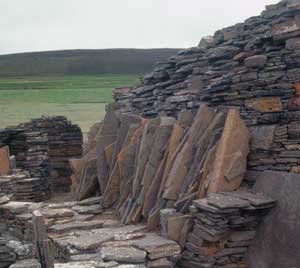
Buttressing along the north-western side of the broch |
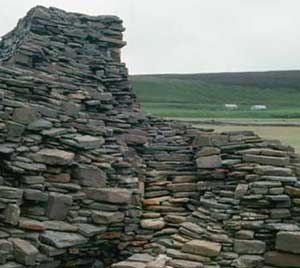
Secondary masonry in the ground floor gallery |
The broch tower has been much robbed to build the dykes and field walls seen nearby but still survives to a height of a little more than 4 metres in places. The drystone masonry is superb and their aren’t too many people alive today who could replicate it. It measures about 18 metres across (about 10 metres internally).
The entrance is very similar to the one at Gurness. The outer door is about 2 metres high (the inner one, slightly less) and a little over a metre across, tapering slightly towards the top. There are checks a little more than halfway along the length of the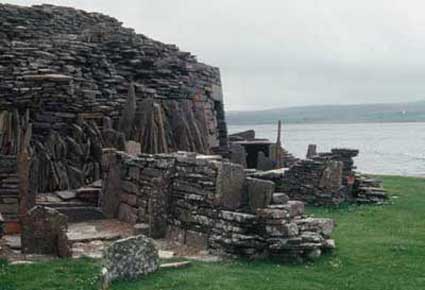 passage, against which a wooden door could be fitted from the inside. Again there is a pair of guard cells with low entrances near the inner end of the passage. The cells have relatively high, corbelled ceilings. The southern one is 2.35 metres high and the northern one is about 30 cm higher. There is a ‘bar hole’ running from the southern cell but, in this case there is no corresponding socket on the opposite side to receive the end of the beam. Even more important, the bar hole is on the wrong side of the door (unless the intention was to lock people in). It may well be that we are being mislead by our preconceptions and that these openings served some other purpose. At the back of the northern cell is a narrow crack that leads into the ground floor gallery, which is about 75 cm wide and anything from 1.5-2 metres high. Above the entrance passage on the inside is a cell the same width as the doorway, rising about a metre high and penetrating the broch wall for a distance of 2.8 metres.
passage, against which a wooden door could be fitted from the inside. Again there is a pair of guard cells with low entrances near the inner end of the passage. The cells have relatively high, corbelled ceilings. The southern one is 2.35 metres high and the northern one is about 30 cm higher. There is a ‘bar hole’ running from the southern cell but, in this case there is no corresponding socket on the opposite side to receive the end of the beam. Even more important, the bar hole is on the wrong side of the door (unless the intention was to lock people in). It may well be that we are being mislead by our preconceptions and that these openings served some other purpose. At the back of the northern cell is a narrow crack that leads into the ground floor gallery, which is about 75 cm wide and anything from 1.5-2 metres high. Above the entrance passage on the inside is a cell the same width as the doorway, rising about a metre high and penetrating the broch wall for a distance of 2.8 metres.
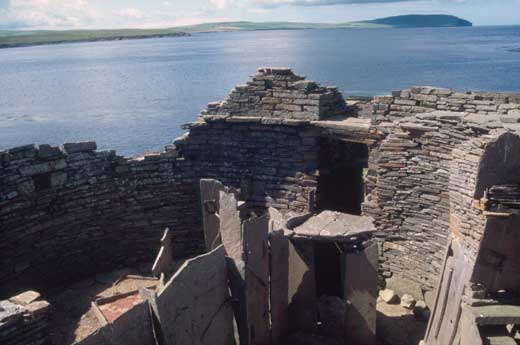
Interior of the Broch, looking towards the entrance (note the cell over the door).Blocking the view of the lower part of the entrance is the ‘press’
There is a scarcement visible about 3.5 metres above the floor that presumably runs the whole way around the inside face of the broch wall. There is an opening to a cell at this level but it appears to have been inserted after the broch was built. Still, it would seem to indicate that the scarcement was meant to support an upper storey rather than the roof. When the broch was built, the ground floor gallery was provided with a flagstone ceiling that also served as the floor to an upper gallery. This was approximately 1.8 metres above the floor, the same level as the top of the door and a ledge running south from it, so there was undoubtedly an intermediate storey, even if it was only a mezzanine.
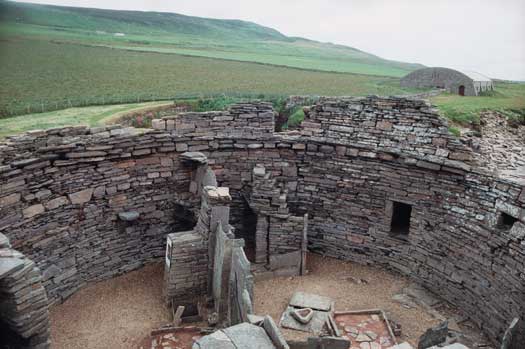
Interior of the broch, showing the scarcement, main partition wall & flight of steps. In the background is the Neolithic tomb of Midhowe in its protective building.
The interior was divided by an east-west partition wall into two roughly equal apartments—each with a kerbed hearth, sunken stone-lined tanks and various compartments— but this is undoubtedly not the original configuration. There was a small vestibule just inside the entrance that gave access, through a doorway and a small lobby, to each half— one of the stone door sockets was found in place.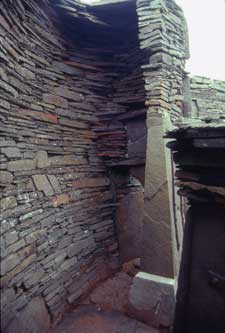 The partition was mainly formed by a line of upright slabs of sandstone—first a row of five set edge to edge, then a pillar of drystone masonry, and finally three slightly overlapping uprights.
The partition was mainly formed by a line of upright slabs of sandstone—first a row of five set edge to edge, then a pillar of drystone masonry, and finally three slightly overlapping uprights.
On the right as you enter the northern apartment is a structure described as a press. It is essentially a flagstone compartment with a single shelf that was built up against the back of the vestibule wall. There is a skin of masonry along the inner face of the broch wall that runs about a quarter of the way around the circumference. Part of it forms one side 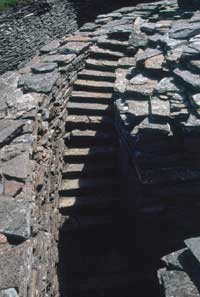 of a domed alcove (right) about one metre across. The other side is made up of a single slab measuring about 228 cm high, 5 cm thick and 68 cm broad with drystone masonry above. The masonry on both sides and at the back is corbelled to form the ceiling of the alcove, 3.12 metres above the floor. The back wall of the alcove is another upright flagstone, beyond which were a number of small compartments. Above these, the builders set large flagstone, 1.39 x 1.7 metres, into the stonework but we have no idea why. A little further along the wall is a doorway set 1.75 metres above the floor and leading to an intramural staircase (left). Fifteen steps survive, winding clockwise to at least the level of the scarcement but it is impossible to say how much higher it may have gone since the broch itself only survives to this height in this quadrant. There appears to have been another, larger compartment in the eastern corner of the room—at least there are two upright flags set in a line about 1.5 metres from the wall.
of a domed alcove (right) about one metre across. The other side is made up of a single slab measuring about 228 cm high, 5 cm thick and 68 cm broad with drystone masonry above. The masonry on both sides and at the back is corbelled to form the ceiling of the alcove, 3.12 metres above the floor. The back wall of the alcove is another upright flagstone, beyond which were a number of small compartments. Above these, the builders set large flagstone, 1.39 x 1.7 metres, into the stonework but we have no idea why. A little further along the wall is a doorway set 1.75 metres above the floor and leading to an intramural staircase (left). Fifteen steps survive, winding clockwise to at least the level of the scarcement but it is impossible to say how much higher it may have gone since the broch itself only survives to this height in this quadrant. There appears to have been another, larger compartment in the eastern corner of the room—at least there are two upright flags set in a line about 1.5 metres from the wall.
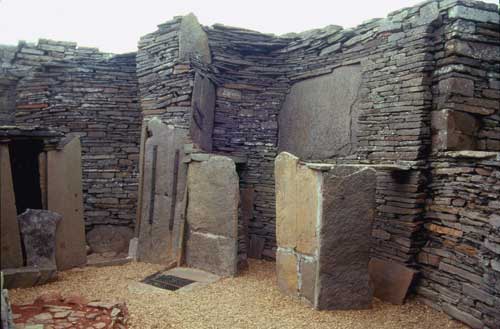
View of the northern apartment from the south, showing the end of the inner skin wall on the right and the ‘press’ on the left. Under the grill is the so-called ‘cellar’
The excavators discovered a subterranean chamber, covered by slabs, located roughly in the centre of the northern apartment. It is pretty much rectangular in shape, roughly 2.1 metres long by 1.4 metres across and 2.65 metres deep. At first they assumed it to be a well but, since it did not seem to be fed by a spring, they later suggested it might have been a cellar. On the other hand, it ties in well with more recent notions of a religious function for this sort of underground chamber. The remains of a hearth sat partly over one of the large slabs used to close the opening to the ‘cellar’ and traces of a second heath were found overlying it. It is generally assumed that these were designed to hold water, but whether for drinking, cooking or keeping fish is not so obvious.
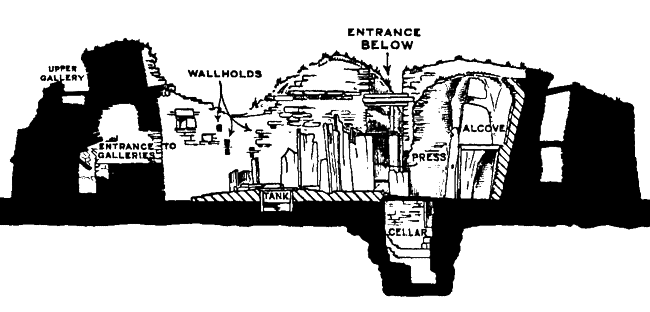
South-North Section of the Broch (W. G. Grant)
The southern apartment had a lot of similar features but some unique ones as well. A small lobby off the vestibule was closed by a wooden door—the pivot stone was still in situ against the north door jamb. There was a succession of stone lined hearths in the centre of the room, with different orientations. Next to them is a well build stone lined tank about 60 cm deep, covered by a single slab that has long since broken in two. The tank is evidently filled by a freshwater spring. The excavators remark on how there was a constant supply of clear, highly potable water during their years at the site.
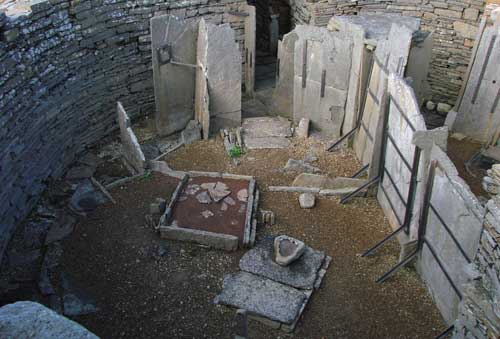
Southern Apartment from the East, looking towards the Main Entrance
The inner broch wall was apparently lined with a double row of cubicles, now pretty much smashed to bits. They are better preserved in the north-eastern corner of the room where they are oversailed by a flight of stairs, of which only the top five steps have been preserved, leading to the entrance to an intramural cell above the scarcement. Also running around the perimeter of the broch wall is a well-built drain, found with some of its cover stones still in place. It drains towards the main entrance but the excavators were not able to discover its outlet.
The small finds from the broch include a number of bone tools (mainly borers and weaving combs) along with food processing equipment (both rotary and saddle querns), so there was certainly domestic activity taking place. Whoever the occupants were, they were certainly well connected as a few sherds of Samian Ware, a highly distinctive glossy red pottery made in central Gaul during the first and second centuries AD were recovered along with a crushed bronze patera(a sort of ladle used by the Romans for libations) of similar date.
The Out Buildings
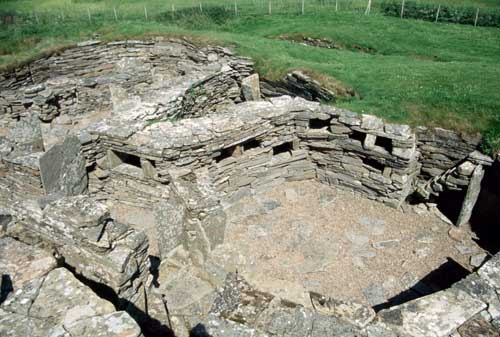
View of Building H from the southeast and above
The remains of a number of outbuildings can be found today, clustered on the north side of the broch, between it and the ramparts or the Geo of Broch, but clearly there had been others that have since disappeared. Only one building (H) could be outlined in full and it had been much remodelled. There are parts of at least three oblong buildings to the west of Building H. One of these (G) contained a hearth that was found covered with masses of slag and ash and was evidently used for smelting iron—although that does not seem to have been its original function. As to the function of the others, it is difficult to say. They all had plenty of storage space—compartments and small, built-in cupboards (‘aumbries’)—but no trace of ordinary domestic hearths were found in any of them. The small finds are few in number and not a big help, but they do include querns for grinding grain and bone borers for working leather. A few spindle whorls and a bone weaving comb show that textiles were being produced.
Building H was subsequently partitioned by rather substantial walls, which were liberally provided with aumbries. A small cellar was found in H4 while H3 contained a set of stairs leading to the top of the rampart. These modifications seem to have taken place at about the same time as the ones to the broch tower when it began to show signs of immanent collapse. Originally, Buildings F, G and H had doorways that opened on a narrow passage next to the broch but when this space was needed for the stone buttresses, the doorways were blocked. At about the same time, a number of cubicles were added to the front of the broch.
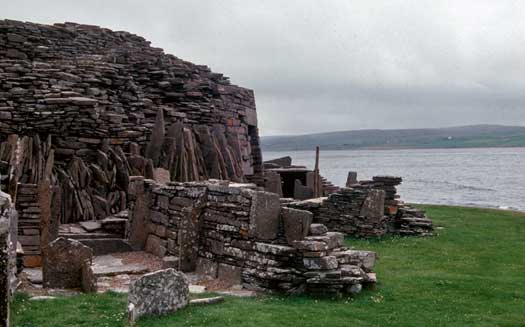
Buildings on NW side of the Broch (Building F in the Foreground)
Additional structures were built to the south and east of the broch but not much of them remain and it is impossible to say exactly when they were built. Some pottery was had been placed in a cubicle at the foot of the steps leading up from Stenchna Geo and a number of crucibles, used for melting bronze, were found nearby along with some strips of sheet bronze.

